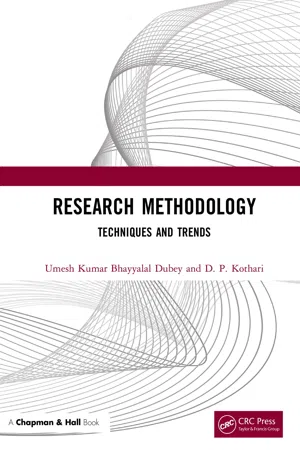Social Sciences
Sampling in Sociology
Sampling in sociology refers to the process of selecting a subset of individuals or groups from a larger population for research purposes. It is a crucial method for gathering data and making generalizations about a population. Different sampling techniques, such as random sampling, stratified sampling, and convenience sampling, are used to ensure the representativeness and reliability of the data collected.
Written by Perlego with AI-assistance
Related key terms
11 Key excerpts on "Sampling in Sociology"
- No longer available |Learn more
- Levent Altinay, Alexandros Paraskevas, SooCheong (Shawn) Jang(Authors)
- 2015(Publication Date)
- Routledge(Publisher)
5 SamplingPeople are pretty much alike. It’s only that our differences are more susceptible to definition than our similarities. (Linda Ellerbee, Broadcast Journalist, 1944–)When undertaking any research, it is essential that you obtain data from people who are as representative as possible of the group you are studying. Even with the perfect questionnaire or interview guide (if such a thing exists), your data will only be regarded useful when your respondents are representative of the population as a whole. For this reason, a clear understanding of the principles of sampling is essential in order to conduct any type of research, whether quantitative or qualitative. Imagine a researcher investigating how tourism policies are developed for a destination or a country. This researcher obviously needs expert opinion, and most probably the views of those who develop policies. Even if the researcher develops an excellent questionnaire or interview guide, appropriate responses will not be acquired if the people interviewed are local people and/or visiting tourists. These respondents will probably not have any idea about how policies are developed.What is sampling?
Sampling is the process by which researchers select a representative subset or part of the total population that can be studied for their topic so that they will be able to draw conclusions regarding the entire population. These conclusions and any generalizations the researcher makes are only as good as the sample they are based on. The obvious advantage of sampling is that the smaller number of elements (e.g. people, organizations) to be studied makes the research more manageable and time-efficient, less costly, and potentially more accurate (since it is more feasible to maintain control over a smaller number of elements). For example, if your research looks at how consumers in the People’s Republic of China make their travel decisions, it is clearly impossible to send 1.3 billion questionnaires in order to cover the entire population. You will need to select a sample of people that is, as far as possible, representative of the entire population of China. This, of course, is quite a challenge. All samples deviate from the true nature of the overall population by a certain amount, owing to chance variations in the selection of the sample’s few elements from the population’s many possible elements. This is called sampling error, and can be reduced by selecting a large sample and by using efficient sampling design. - eBook - ePub
Quantitative Research Methods in Communication
The Power of Numbers for Social Justice
- Erica Scharrer, Srividya Ramasubramanian(Authors)
- 2021(Publication Date)
- Routledge(Publisher)
And when particular sampling procedures are followed, the idea of giving voice is amplified beyond those directly studied into larger populations, a unique strength of quantitative research for social justice. Sampling is the process of “deciding what to observe and what not to observe” (Babbie, 2010, p. 189). It sounds so straightforward, and in many ways it is. But, just like with any researcher-originated decision, there are a number of key considerations and important implications when deciding how to draw a research sample. Thankfully, as we have seen with the process of operationalization, there are widely accepted guidelines, principles, and approaches, many of which are established through applying the principles of the scientific method. In this chapter, we will introduce those guidelines, principles, and approaches as well as consider the social justice implications of each. The question of who or what will comprise the research sample is vitally important in quantitative social science research. In fact, it is one of the central elements of what we have called “the power of numbers.” One of the chief strengths of quantitative research is its ability to explore patterns that are determined to be widely shared—or, conversely, are shown to be relatively rare—within a large and potentially heterogeneous group. As we saw in Chapter 1, qualitative research typically uses small samples and is not always concerned about generalizing findings to a larger population. Qualitative research, therefore, can tell us a whole lot about a relatively small body of people or of texts. But those observations may well be quite unique to that small group, and therefore their applicability to a broader body can be limited. In quantitative research, we draw somewhat less detailed observations from a larger body of people or of texts. In doing so, we strive to say something more widespread and more general about the phenomenon we are studying - eBook - ePub
- John Ambenge(Author)
- 2021(Publication Date)
- Page Publishing, Inc.(Publisher)
A population is any precisely defined group, such as all women, men, institutions, newspaper articles, students, teachers, or a host of other things that represent the whole. Because it is usually or almost impossible to interview or administer a questionnaire to every single person in the population, choices must be made. The population that is being surveyed may consist of any social category—prisoners, gays and lesbians, waiters/waitresses earning $10,000—or the entire nation. Surveys are the most widely used research method in the social sciences.SampleA sample refers to any subgroup selected from an entire population in such a way that it is representative of the larger group. To draw a sample from which one can safely generalize, researchers must choose respondents at random. The researcher must decide how to select which cases to study to see if the predicted relationship holds. The best way to go about it is to use a sample. The sample, however, must accurately represent the entire population from which it is drawn. Otherwise, the information obtained from the sample cannot be generalized to the population. If a sample is to be representative, all members of the population must have the same chance of being selected for the sample. This means that you use a sample that accurately represents the population in your study. So how can you get a representative sample?Types of SamplingThe best way is to use a random sampling, a method of sampling in which everyone in the target population has the same chance of being included in the study. Researchers commonly use random sampling to select enough sample of the population that ensures a high probability of every person in the population having an equal chance of being included in the sample. To obtain a random sample, a researcher collects a complete list of all the members of the population that is to be studied. For example, a professor decides to investigate students’ performance on a sociology test. The professor decides to put the names of the students enrolled in his/her sociology course in a larger hat and draws out some of the names. What the professor is doing will be random sampling, since all the names have an equal chance of being selected for the study. Random sampling provides valid or logical generalizations and, hence, is widely used in practice. Random samples of adequate size allow the researcher to accurately generalize or describe patterns of behavior of a larger population based on findings from a sample. - eBook - ePub
Dissertation Research Methods
A Step-by-Step Guide to Writing Up Your Research in the Social Sciences
- Philip Adu, D. Anthony Miles(Authors)
- 2023(Publication Date)
- Routledge(Publisher)
Figure 16.1 illustrates the major steps in the sampling process.Source: Adopted from Sekaran and Bougie (2013).Figure 16.1The sampling process.Before choosing a specific type of sampling technique, a broad sampling technique needs to be decided on. One of the difficult aspects of research is launching an experience-sampling study. It can provide a challenge to even the most seasoned researcher (Christensen et al., 2003 ). When a researcher decides to begin the research process, they must go through the sampling process first. The first stage in the sampling process is to clearly define the problem. Defining the problem is the basis for all research. This also relates to determining the sampling frame. The sampling frame must be representative of the population of interest. This is vital to the research.The next step is to determine the sample design. Establishing the sample design is very important to the researcher. The next step is to determine the appropriate sample size for the study. We have to remember that the population is commonly related to the number of people living in a particular area of the country. Lastly, the researcher has to execute the sampling process. Again, sampling can be used to make inferences about a population.Types of Sampling
The practice of sampling can be used to make an inference about a population or to make a generalization in relation to an existing theory. This is based on the choice of sampling technique.The practice of evaluating the characteristics of an entire population through a representative sample can be an arduous endeavor. As with many research studies, the best strategy to investigate a problem in an entire population is through the use of sampling. How, it is not always possible to conduct a study on an entire population. So, we use the practice of sampling. Thus, the researcher studies a sample of the population, which is a suitable representation of the entire population. We must think of a sample as a subset of the population; thus it is selected to be representative of the population. Again, one of the advantages of sampling is that it can be less costly and more efficient. Being able to use a sample to generalize the results to a whole population requires the use of one of the statistical sampling methods for evaluation. Taking a subset from a chosen sampling frame or entire population is the basic practice of sampling. - eBook - ePub
Essential Environmental Science
Methods and Techniques
- Simon Watts(Author)
- 2003(Publication Date)
- Routledge(Publisher)
In all these studies, because it is impossible to collect every relevant measurement, the strategy of examining a limited number of measurements has been adopted. Nobody would claim that thirty weather stations could reveal all the subtleties of New England's climate, yet short of establishing a continuous cover of rain gauges and Stephenson screens over the region, this is the only practicable way of approaching the subject. Similarly, with the geological example, it is not possible to analyse all the lower Carboniferous rock in Britain, so a number of sections which happen to be exposed at the surface are taken as representing all the unseen rock buried underground. In the same way, detailed study of the reactions of 300 people might allow us to draw conclusions about the reactions of people in general, just as the results of an experiment with 150 rats give an idea about the results we would expect if all the rats in the world could be tested. In all cases a sample has been selected for detailed study. The sample is selected from a much larger (perhaps infinite) group in which we are interested. This larger group is termed the population.2.2 Sampling in the social environmental sciences
2.2a Random sample selection
Random sampling offers the best chance of drawing a representative sample from your sampling frame (a sampling frame is the window through which you view your target population. A sampling frame for the adult population of a small area of the UK might be the electoral register, which lists the names and addresses of everybody eligible to vote). These methods normally involve the use of tables of random numbers to ensure the selection of a representative sample. Here every individual listed in the sampling frame is numbered sequentially. Once this has been done, you are ready to select your sample in a fair way using one of the following methods.see chapter 9i Simple random sampling
This is the most straightforward method of random sampling. It can be done in two ways: with and without replacement. When sampling with replacement, once an individual has been selected they are returned to the ‘pot’ and have an equal chance of being re-selected. In theory, this means that in a sample of size n, the same individual could be selected n times! Hence, whatever the statistical attractions of all individuals having an equal chance of being chosen at each and every instance of selection, sampling without replacement is more commonly used. In this case, selected individuals are not returned to the ‘pot’, meaning that the chance of any individual being selected increases with each successive individual selection.To select your sample you need a sequentially numbered sampling frame and either a computer program that can generate random numbers (e.g. Excel), or a table of random numbers. Table 2.1 shows part of a random numbers table and Box 2.1 - No longer available |Learn more
Analyzing Media Messages
Using Quantitative Content Analysis in Research
- Daniel Riffe, Stephen Lacy, Brendan R. Watson(Authors)
- 2019(Publication Date)
- Routledge(Publisher)
5 Sampling A question content analysts must ask is, “How much data would be needed to adequately test the hypotheses or answer the research questions?” In an ideal world, sampling would not be an issue for social scientists. Researchers would include all relevant content in their studies. For example, a study concerning gender representation on television would examine every program on every channel during all pertinent time periods. However, researchers face trade-offs between the ideal and practical limitations of time and money. Coding all relevant content with human coders is impractical when thousands or even millions of content units are in the population. In other situations, researchers find that all content cannot be obtained. Because of a number of issues discussed below, most content analysts use a sample of all relevant content rather than a census. How a researcher selects a sample is extremely important because it determines the appropriate type of statistics that will be used (inferential or descriptive) and the extent to which the results can be generalized. Social science theory aims to describe people’s behavior and mental processes. The more representative the data, the more valid are the conclusions for the represented group. A sample is a subset of units from the entire population being studied. The usual goal of such samples is to represent the population. When probability samples (units are randomly chosen) are selected, scholars can make valid inferences about the population of content under study. The inferences drawn from a probability sample are subject to sampling error, but statistical procedures enable researchers to estimate this sampling error with a given level of probability. If researchers assemble samples in any way other than random sampling (and many do or must), sampling error cannot be calculated accurately. It becomes impossible to estimate how much the sample differs from the population from which it was taken - eBook - ePub
Research Methodology
Techniques and Trends
- Umesh Kumar B Dubey, D P Kothari(Authors)
- 2022(Publication Date)
- Chapman and Hall/CRC(Publisher)
n.” A sample is any number of persons selected to represent the population according to some rule of plan. Thus, a sample is a smaller representation of the population. A measure based on a sample is known as a statistic.6.2.4 Sample Size and Sampling Design or Strategy
Sample size is the number of selected individuals from whom you obtain the required information; it is usually denoted by the letterFor example, number of students, number of family members, etc.( n ).6.2.4.1 Sampling Design or Strategy
The sampling design or strategy is the way researcher selects the sample or students or families, etc. It refers to the techniques or procedures the researcher would adopt in selecting some sampling units from which inferences about the population are drawn.6.2.5 Sampling Units
At some stage of the sampling process, a sampling unit is that element or elements considered available for selection. Sampling units and the elements are same in single-stage sampling. For example, the relevant population for conducting a socioeconomic survey in a region. In this case a sample of households may be selected in three stages. First, a sample of Tehsils is selected. Then, from each selected Tehsil a sample of villages is selected after making a list of all the villages in it. Finally, from each selected village, a sample of households is selected after listing all the households in it. In this example, Tehsils are taken as first stage unit, villages as second stage unit, and households as the third or the final stage unit. Each individual or case that becomes the basis for selecting a sample is called sampling unit or sampling elements. - eBook - ePub
- Judy L. Krysik(Author)
- 2018(Publication Date)
- Routledge(Publisher)
Important choices in the formulation of a sampling plan include what to study and whether to collect data from the whole population or to limit data collection to a sample. A population is the totality of persons, events, organizational units, and so on that the research problem is focused on. A sample, in contrast, is a subset of the population. As one example, if a researcher conducted a study of students at your school, the population would consist of the entire student body. Any subset of that population—for example, 100 students picked at random—would represent a sample. In instances when sampling is the preferred approach, researchers must decide how to select the elements they wish to study. In sampling, the term element refers to each member or entity in the population. Another question that the sampling plan must address is “How big should the sample be?” Finally, the plan must indicate whether the sampling method will permit inferences. By making an inference, the social work researcher is claiming that what holds for the sample is likely true for the population from which the sample was drawn. In the example just cited, the researcher would assume that the results of the study of 100 students could be generalized to the entire student population. Exhibit 8.1 outlines the steps that the researcher will address in the formulation of a sampling plan - Graham Allan, Chris Skinner(Authors)
- 2020(Publication Date)
- Routledge(Publisher)
Once you know, in realistic terms, the size of your survey population, the question of whether or not to take a sample is answered by adding the number of completed questionnaires you would like to obtain to an estimate of the number of non-respondents. If the total is less than the survey population, then there is scope for sampling. Choosing the type of sampling from those outlined in earlier paragraphs is basically about ensuring that your sample group is as typical as possible of the whole survey population, thereby maximizing scope to make generalizations from your results. In academic research randomness tends to be favoured, while taking a quota can be looked down on as the province of market researchers. In reality a useful approach is to analyze the survey population to see how much stratification might be feasible, and aim to select as randomly as possible from within a sensible stratified framework.It follows that the first phase of taking a sample is a careful process of selection leading to a suitable framework for the sample. The next phase may be a quota or stratification: for example, if you wanted to interview ten people of each gender, in each of several age groups, from among those attending hospital out-patient clinics, you might well opt to take the first ten who arrive in each category. In contrast you may select in a more random way if you have access to a list of names and addresses for your survey population, such as the Electoral Register. Here, depending on the size of the sample as a proportion of the total list, you can take a systematic sample of every nth name; or you can select a simple random sample by giving everyone on the list a number, and then using a computer to generate random numbers, or use random number tables.Almost all survey researchers agonize over the issue of sample size. Often it is a matter of seeking a compromise between the researcher’s resources and the need for generalizable (statistically valid) results. The larger the sample, the greater the prospect of such results, but the higher the cost in time and money. Sadly there is no easy route at a planning stage by which sample sizes and the consequent validity of results can be calculated because a crucial factor is the extent of diversity in the survey population. A more diverse group requires a bigger sample. At a practical level, keep in mind that stratification is a process of taking account of some of the diversity (controlling variables), so can influence sample size. In reality, most postgraduate researchers will take the largest sample their time and resources permit.- eBook - ePub
Researching Health Needs
A Community-Based Approach
- Judy Payne(Author)
- 1999(Publication Date)
- SAGE Publications Ltd(Publisher)
Chapter 9 .The key requirement of your sample is that it is representative of the population. This means that the various groups and types of person in the community are included in the sample to the same extent as they are in the population. You will also have to allow for how varied your population is in relation to the information you want (for example, in terms of age, gender, occupation, etc.). If the people are very different, you have to try to ensure that you will include representatives of all the various types by selecting a larger sample or by using some method of selecting from each of the groups (stratified sampling). However, the total number of people that you select will be mainly determined by your resources.If you do not have or cannot compile a list of your population, you can use a non-probability sampling method – quota sampling, snowballing and purposive sampling. Here the researcher or the respondent or both influence the selection process. Because this process is not statistically random, it is not possible to assess, with any confidence how good a representation your sample is of your population. In exploratory and qualitative studies, this may not be important. However, non-random selection does limit the generalizability of the claims you may make for your results. Non-probability sampling methods are discussed later in this chapter.Simple random sampling
If you have a suitable population list in which everyone has an equal chance of being selected – one that is not ordered in any way and does not contain duplicates – then you can draw a simple random sample. The most common methods of selection are by lottery, by using random numbers and by systematic sampling. In all of them you will need to know the size of your population and of your sample, and your list must be numbered. This list is referred to as a sampling frame - eBook - ePub
Quantitative Techniques in Business, Management and Finance
A Case-Study Approach
- Umeshkumar Dubey, D P Kothari, G K Awari(Authors)
- 2016(Publication Date)
- Chapman and Hall/CRC(Publisher)
8.4.2 Probability SamplingThis provides a scientific technique of drawing samples from the population according to some laws of chance in which the universe has some definite preassigned probability of being selected in the sample.Different types of sampling are where- Each sample unit has an equal chance of being selected.
- Sampling units have varying probabilities of being selected.
- The probability of selection of a unit is proportional to the sample size.
8.4.3 Mixed Sampling
Sampling design in which the sample units are selected partly according to some probability laws and partly according to a fixed sampling rule (no use of chance) is called mixed sampling.When a sample is required to be selected from a population, it is necessary to decide which method is to be applied. The choice would depend on the nature of the data and the purpose of the inquiry. The various methods available for sampling are- Simple random sampling
- Stratified sampling
- Systematic random sampling or quasi-random sampling
- Cluster sampling
- Multi-stage sampling
- Area sampling
- Quota sampling
8.5 Simple Random Sampling
In this technique, a sample is drawn so that each and every unit in the population has an equal and independent chance of being included in the sample. If the unit selected in any draw is not replaced in the population before making the next draw, then it is called simple random sampling without replacement (SRSWOR).And if it is replaced before making the next draw, then the sampling plan is called simple random sampling with replacement (SRWSR). An important feature of SRSWOR is that the probability of selecting a specified unit of a population at any given draw is equal to the probability of its being selected at the first draw.
Index pages curate the most relevant extracts from our library of academic textbooks. They’ve been created using an in-house natural language model (NLM), each adding context and meaning to key research topics.










